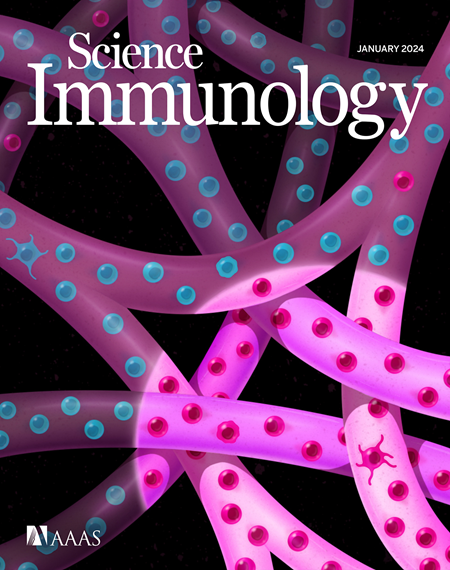MIZ1-TMBIM4 对 BCR 介导的 Ca2+ 调动的调控保障了 IgG1+ GC B 细胞的阳性选择
IF 17.6
1区 医学
Q1 IMMUNOLOGY
引用次数: 0
摘要
从免疫球蛋白 M (IgM) 到亲和成熟的 IgG 抗体的转变对于有效的体液免疫至关重要。生殖中心(GCs)通过亲和成熟和优先维持 IgG+ B 细胞而不是 IgM+ B 细胞促进了这一转变。然而,目前还不清楚生殖中心内不同 Ig 异型的正向选择是否依赖于特定的转录机制。在这里,我们使用 CRISPR-Cas9 筛选和条件小鼠遗传学方法探索了 IgG1+ GC B 细胞转录因子的依赖性。我们发现,在正向选择过程中,IgG1+ GC B 细胞的存活特别需要 MIZ1,而 IgM+ GC B 细胞在很大程度上是独立的。从机制上讲,MIZ1诱导了TMBIM4,TMBIM4是一种祖先的抗凋亡蛋白,可调节IgG1+ B细胞中B细胞受体(BCR)信号传导下游的肌醇三磷酸受体(IP3R)介导的钙(Ca2+)动员。MIZ1-TMBIM4 轴阻止了 Ca2+ 过度积累引起的线粒体功能障碍诱导的 IgG1+ GC 细胞死亡。这项研究揭示了一种独特的 Ig 同型特异性依赖性,即在 GC 阳性选择中存在一种迄今尚未发现的机制。本文章由计算机程序翻译,如有差异,请以英文原文为准。
Regulation of BCR-mediated Ca2+ mobilization by MIZ1-TMBIM4 safeguards IgG1+ GC B cell–positive selection
The transition from immunoglobulin M (IgM) to affinity-matured IgG antibodies is vital for effective humoral immunity. This is facilitated by germinal centers (GCs) through affinity maturation and preferential maintenance of IgG+ B cells over IgM+ B cells. However, it is not known whether the positive selection of the different Ig isotypes within GCs is dependent on specific transcriptional mechanisms. Here, we explored IgG1+ GC B cell transcription factor dependency using a CRISPR-Cas9 screen and conditional mouse genetics. We found that MIZ1 was specifically required for IgG1+ GC B cell survival during positive selection, whereas IgM+ GC B cells were largely independent. Mechanistically, MIZ1 induced TMBIM4, an ancestral anti-apoptotic protein that regulated inositol trisphosphate receptor (IP3R)–mediated calcium (Ca2+) mobilization downstream of B cell receptor (BCR) signaling in IgG1+ B cells. The MIZ1-TMBIM4 axis prevented mitochondrial dysfunction–induced IgG1+ GC cell death caused by excessive Ca2+ accumulation. This study uncovers a unique Ig isotype–specific dependency on a hitherto unidentified mechanism in GC-positive selection.
求助全文
通过发布文献求助,成功后即可免费获取论文全文。
去求助
来源期刊

Science Immunology
Immunology and Microbiology-Immunology
CiteScore
32.90
自引率
2.00%
发文量
183
期刊介绍:
Science Immunology is a peer-reviewed journal that publishes original research articles in the field of immunology. The journal encourages the submission of research findings from all areas of immunology, including studies on innate and adaptive immunity, immune cell development and differentiation, immunogenomics, systems immunology, structural immunology, antigen presentation, immunometabolism, and mucosal immunology. Additionally, the journal covers research on immune contributions to health and disease, such as host defense, inflammation, cancer immunology, autoimmunity, allergy, transplantation, and immunodeficiency. Science Immunology maintains the same high-quality standard as other journals in the Science family and aims to facilitate understanding of the immune system by showcasing innovative advances in immunology research from all organisms and model systems, including humans.
 求助内容:
求助内容: 应助结果提醒方式:
应助结果提醒方式:


